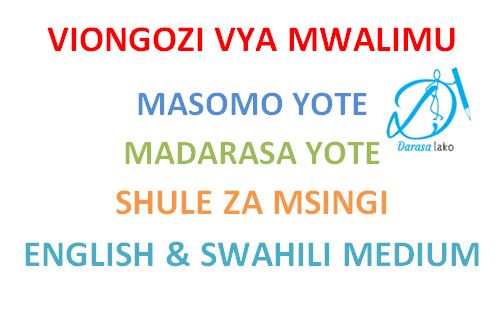Teachers guide books
Teacher's guide books are resources designed to assist educators in planning, implementing, and assessing instruction effectively. These books typically provide guidance on various aspects of teaching, including curriculum development, lesson planning, classroom management, assessment strategies, and student engagement techniques. They may also offer insights into educational theories, teaching methodologies, and best practices for different subject areas or grade levels.
Teacher's guide books often include:
Choose here (chagua) 👇
👉Swahili medium teachers guide books
👉English medium teachers guide books
👉Viongozi vya mwalimu.....
Lesson Plans: Detailed plans for individual lessons, including objectives, instructional activities, materials needed, and assessment methods.
Curriculum Alignment: Suggestions for aligning instructional materials and activities with curriculum standards and learning objectives.
Assessment Tools: Strategies for assessing student learning, including formative assessments, summative assessments, rubrics, and other evaluation methods.
Differentiation: Tips for meeting the diverse needs of students through differentiated instruction, including strategies for accommodating various learning styles, abilities, and backgrounds.
Classroom Management: Techniques for creating a positive and productive learning environment, managing student behavior, and fostering a sense of community within the classroom.
Technology Integration: Ideas for incorporating technology tools and resources into instruction to enhance learning experiences and engagement.
Professional Development: Resources for teacher self-improvement, including suggestions for further reading, workshops, and other professional development opportunities.
Parent Communication: Strategies for effectively communicating with parents or guardians, involving them in their child's education, and addressing concerns or questions they may have.
Teacher's guide books can vary widely depending on the subject matter, grade level, and educational philosophy. They are valuable resources for both novice and experienced educators seeking to enhance their teaching practices and improve student outcomes.
English medium teaching guide
An English medium te
aching guide typically focuses on teaching English as a second or foreign language in educational settings where English is the medium of instruction. These guides are designed to support teachers in effectively teaching English language skills, including speaking, listening, reading, and writing, to students whose first language may not be English. Here are some common components you might find in an English medium teaching guide:
Language Skills Development: Strategies for developing each language skill (listening, speaking, reading, writing) through communicative activities, games, and exercises.
Grammar and Vocabulary: Guidance on teaching grammar rules, sentence structures, and vocabulary acquisition in a systematic and engaging way.
Lesson Planning: Tips for creating well-structured lesson plans that incorporate language objectives, appropriate activities, and assessment methods.
Teaching Techniques: Various teaching techniques and methodologies such as communicative language teaching, task-based learning, and content-based instruction.
Differentiation: Suggestions for accommodating the diverse needs and proficiency levels of students in the classroom through differentiated instruction and scaffolding techniques.
Assessment and Feedback: Strategies for assessing language proficiency and providing constructive feedback to students to support their language development.
Integrating Language Skills: Ideas for integrating language skills into thematic units or interdisciplinary projects to enhance student engagement and language acquisition.
Using Authentic Materials: Suggestions for incorporating authentic materials such as real-world texts, videos, and multimedia resources to expose students to authentic language use and cultural contexts.
Technology Integration: Tips for integrating technology tools and digital resources to enhance language learning opportunities inside and outside the classroom.
Cultural Awareness: Guidance on promoting cultural awareness and sensitivity among students by exploring cultural aspects related to the English language and its speakers around the world.
Professional Development: Resources for teacher self-improvement, including recommendations for further reading, workshops, and online courses focused on English language teaching methodologies and best practices.
These guides are valuable resources for English language teachers working in diverse educational contexts, including schools, language institutes, and international education programs, aiming to help students develop proficiency in English as a second or foreign language.
Quality of better teacher guide book
There are numerous excellent teacher guidebooks available, each catering to different teaching contexts, subjects, and grade levels. Here are a few highly regarded teacher guidebooks that have received positive reviews from educators:
"The First Days of School: How to Be an Effective Teacher" by Harry K. Wong and Rosemary T. Wong: This book provides practical advice and strategies for new and experienced teachers alike, focusing on classroom management, establishing routines, building relationships with students, and creating a positive learning environment.
"Teach Like a Champion 2.0: 62 Techniques that Put Students on the Path to College" by Doug Lemov: This book offers a collection of specific teaching techniques and classroom management strategies derived from observing effective teachers in action. It covers a wide range of topics, including lesson planning, questioning techniques, and academic expectations.
"Understanding by Design" by Grant Wiggins and Jay McTighe: This book introduces the concept of backward design, emphasizing the importance of starting with clear learning objectives and designing instruction to achieve those objectives. It provides a framework for curriculum planning and assessment that promotes deeper understanding and meaningful learning experiences.
"The Reading Strategies Book: Your Everything Guide to Developing Skilled Readers" by Jennifer Serravallo: This comprehensive resource offers practical strategies and lesson ideas for teaching reading comprehension, fluency, vocabulary, and other essential literacy skills. It includes over 300 strategies organized by skill and accompanied by helpful teaching tips and student examples.
"Visible Learning for Teachers: Maximizing Impact on Learning" by John Hattie: Drawing on extensive research, this book synthesizes evidence-based practices that have the most significant impact on student learning. It explores various teaching strategies, classroom interventions, and factors that influence student achievement, providing insights for educators looking to enhance their teaching effectiveness.
"Culturally Responsive Teaching and The Brain: Promoting Authentic Engagement and Rigor Among Culturally and Linguistically Diverse Students" by Zaretta Hammond: This book explores the intersection of neuroscience and culturally responsive teaching, offering practical strategies for engaging culturally and linguistically diverse students and promoting academic success.
These are just a few examples of highly regarded teacher guidebooks, and there are many more available depending on your specific needs and interests as an educator. It's essential to explore different resources and find those that resonate with your teaching style, subject area, and students' needs.


